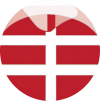Inhalt dieses Beitrages
Langeland is a beautiful island in Denmark that deserves a full travelogue. With an area of 572 square kilometers, it is not large, but still a popular tourist destination. The island belongs to the region Syddanmark and is located directly on the Baltic Sea. It is possible to get to Langeland both by bridge and by water. The bridge connects Langeland with three other islands: Siø, Tåsinge and Fyn.
The island of Langeland is divided into two administrative districts, so-called Harden. In the north there is the Nordharde and in the south the Südharde. The island municipality consists of Tranekaer, Fyn and Rudkøbing, with Rudkøbing being the main town of the municipality. Tranekaer is home to Tranekær Castle, one of the most popular sights on the island.
Langeland offers many other attractions for tourists. The Ristinge cliff in the southern part of the island is an impressive cliff, and the Keldsnor lighthouse is located at the fishing harbor or sailing port of Bagenkop. A special highlight is the museum at the military base Langelandsfort, where among other things the Saab J-35 Draken and MTG-23 aircraft are exhibited. These two jet fighters are relics from the Cold War and attract many visitors.
Langeland is also known for its monuments. Everywhere on the island you can find passage tombs and dolmens, which are impressive prehistoric legacies. Besides the burial mounds, ship settlements and settlements are also important testimonies of past times.
The geological composition of the island is very diverse. Langeland is a hilly island with about 700 mountains, which have a relatively low height of about 15 meters. The hills stretch across the entire island, with the exception of Ristinge. The unique landscape of the island was formed by natural processes.
Another highlight of Langeland is the geological sight called “Keldsnor” in the southern harde. This is a beach lake formed by sea bays and is currently cut off from the open sea.
Beaches:
Langeland is known for its beautiful beaches that invite you to relax, sunbathe and swim. Here are some of the most popular beaches on the island:
Ristinge beach: Ristinge beach is located on the south coast of Langeland and is one of the most beautiful beaches on the island. The wide sandy beach stretches for several kilometers and offers ideal conditions for swimming and sunbathing. The dune landscape and clear water make this beach a popular destination for families and nature lovers.
Nordstrand: Nordstrand is located on the north coast of Langeland and is known for its quiet atmosphere and impressive dune landscape. Here you can find untouched nature and idyllic surroundings. The beach is perfect for long walks and collecting shells.
Bagenkop beach: Bagenkop beach is located near the fishing and sailing port of Bagenkop and offers a picturesque place to relax and enjoy. With its fine sand, clear waters and adjacent seafood restaurants, this beach is ideal for a day by the sea.
Hotels and accommodation facilities:
Langeland offers a variety of hotels, cottages, guesthouses and campsites to meet the needs of different travelers. Here are some accommodation options on the island:
Hotels: There are several hotels on Langeland that offer comfortable accommodation with first-class amenities. From family-run hotels to luxury beach resorts, there is something for every taste and budget.
Vacation homes and apartments: A popular option for a longer stay or for families are vacation homes and vacation apartments. On Langeland there is a wide selection of cozy and well-equipped vacation homes, often located in the middle of nature or near the beach.
Pensions and Bed & Breakfasts: For a charming and personal atmosphere, travelers can choose a pension or a bed & breakfast. These accommodations often offer individually decorated rooms and a warm ambience that makes you feel at home.
Campsites: For nature lovers and outdoor enthusiasts, Langeland also has several campsites. Here you can experience the beautiful nature of the island up close with your own tent or camper.
It is recommended to book accommodation in advance, especially during the summer months, as Langeland is a popular tourist destination and demand for accommodation can be high.
In addition to beaches and accommodations, Langeland also offers a variety of recreational activities such as cycling.
getting there
To get to Langeland from Germany, there are several options. A popular option is to travel by car via the A7 and A1 north to the Danish border. From there, the E20 continues to the island of Fyn, where the bridge to Langeland is located. Alternatively, you can travel by train to Denmark and from there take a ferry or a boat to reach the island. There are regular ferry connections from various Danish ports to the island of Langeland.
No matter which way you choose to travel, Langeland is definitely worth a visit. With its picturesque landscape, historical sights and unique geological diversity, the island offers a variety of activities and experiences for every visitor.
Map of Langeland
[osm_map_v3 map_center=”54.941,10.754″ zoom=”9″ width=”100%” height=”450″ ]
To get to the geology, Langeland is a very hilly island, it has around 700 mountains, which are relatively small, each mountain is around 15 meters high. The hills are scattered all over the island, with the exception of Ristinge. Nature gave Denmark such a unique landscape through natural processes. Another highlight of the island is located on the Südharde, the geological attraction is called “ Keldsnor ” and is a beach lake, but not an ordinary beach lake, this was created by sea bays and is currently cut off from the open sea.

